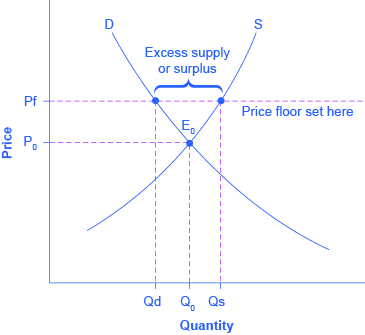A price floor could be set below the free market equilibrium price.
Price floor is binding when it is set.
In this case the floor has no practical effect.
Another way to think about this is to start at a price of 100 and go down until you the price floor price or the equilibrium price.
Above the equilibrium price causing a surplus.
Government laws to regulate prices instead of letting market forces determine prices price floor.
A binding price floor is a required price that is set above the equilibrium price.
A legal maximum price price control.
Setting binding price floors.
A non binding price floor a binding price ceiling.
A price floor is binding when it is set.
A non binding price floor.
An ineffective non binding price floor below equilibrium price.
Types of price floors.
The latter example would be a binding price floor while the former would not be binding.
Governments can set prices on certain goods artificially high and create economic disequilibrium and binding price floors on these goods through the laws they enact.
The government has mandated a minimum price but the.
A price floor is an established lower boundary on the price of a commodity in the market.
Price floors set above the market price cause excess supply a price floor set above the market price causes excess supply or a surplus of the good because suppliers tempted by the higher prices increase production while buyers put off by the high prices decide to buy less.
A legal minimum price for a product.
Binding price floor when a price floor is set above the equilibrium price and results in a surplus price ceiling.
This has the effect of binding that good s market.
T f workers determine the supply of labor and firms determine the demand for labor.
Note that the price floor is below the equilibrium price so that anything price above the floor is feasible.

